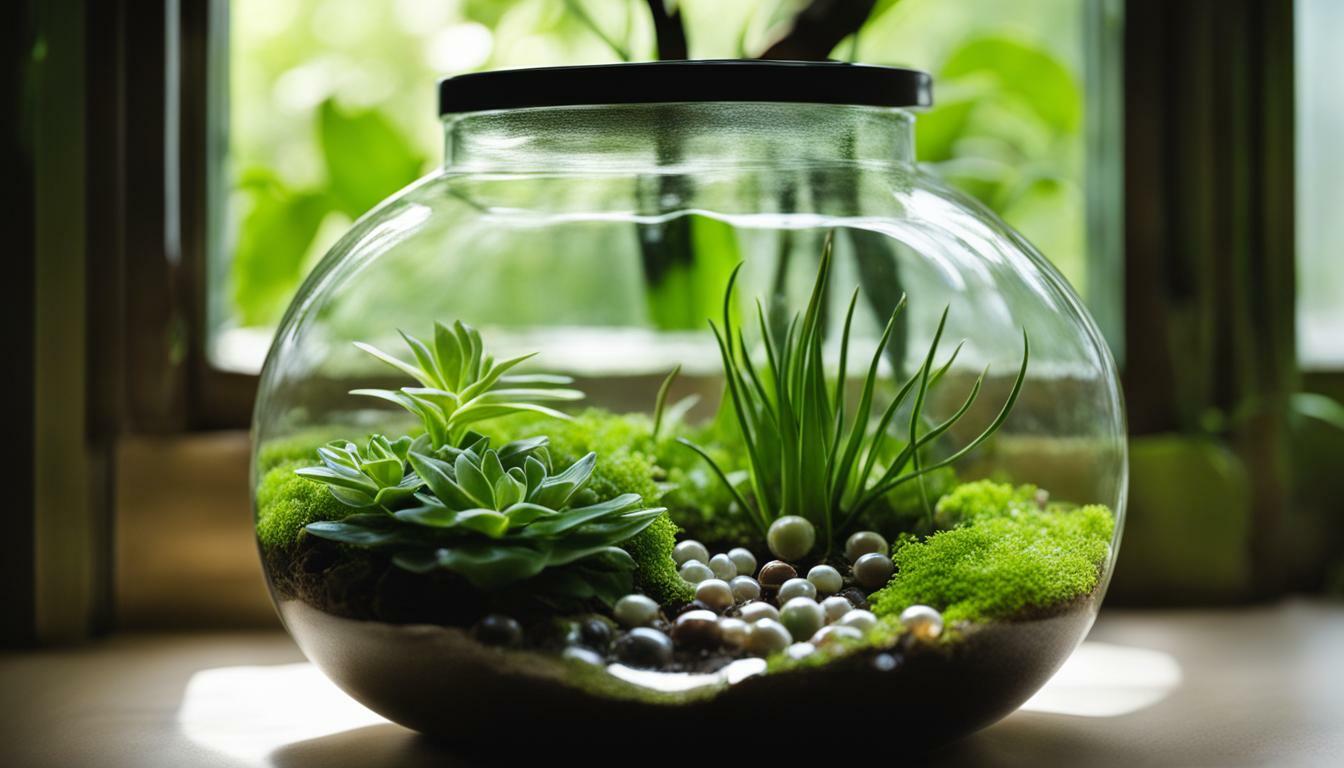Terrariums are captivating glass enclosures that can elevate your indoor garden, and String of Pearls is a standout choice for these miniature worlds. With its unique round, pea-like leaves, this popular succulent adds a whimsical touch to any terrarium, creating a mesmerizing focal point.
Indoor terrariums offer a multitude of benefits, including bringing a touch of nature to small spaces and adding an artistic dimension to your living area. These enchanting ecosystems allow you to create a lush and green environment that requires minimal care and attention.
Key Takeaways:
- String of Pearls is a popular terrarium plant that adds a whimsical touch to any indoor garden.
- Terrariums are glass enclosures that create captivating miniature worlds and elevate your indoor space.
- Indoor terrariums offer numerous benefits, including adding an artistic dimension and bringing nature into small spaces.
- String of Pearls requires bright, indirect light and should be watered lightly, allowing the soil to dry slightly between waterings.
- Terrariums are low-maintenance and can accommodate various types of plants, making them ideal for indoor gardening.
Understanding Terrarium Types: Open and Closed Terrariums
To create a successful terrarium, it’s important to understand the distinction between open and closed terrariums, as they offer different environments for plant growth. Open terrariums provide a drier and less humid environment, making them suitable for plants that prefer lower humidity levels, such as cacti, succulents, and jade plants. Closed terrariums, on the other hand, create a more humid and moisture-rich environment, making them perfect for humidity-loving plants like artillery ferns and prayer plants.
Open terrariums are typically made from glass containers that provide good air circulation and ventilation. These containers allow for the exchange of moisture and gases between the terrarium and its surroundings. The open nature of these terrariums also means that they require less maintenance and monitoring, as the excess moisture evaporates and the humidity levels remain relatively low.
Closed terrariums, on the other hand, are sealed or partially sealed containers that create a self-sustaining ecosystem. The moisture within the closed terrarium condenses on the walls and top of the container, creating a humid environment that mimics a mini greenhouse. This high humidity level is ideal for plants that thrive in tropical or rainforest conditions.
| Open Terrariums | Closed Terrariums |
|---|---|
|
|
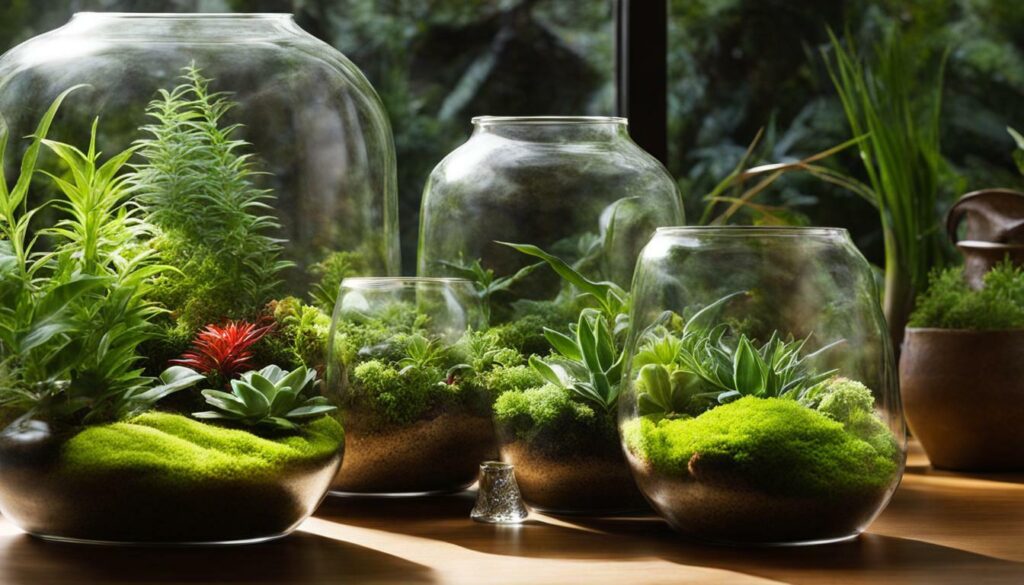
When deciding between open and closed terrariums, consider the type of plants you want to grow and the conditions they thrive in. If you prefer low-maintenance plants that prefer drier conditions, opt for an open terrarium. On the other hand, if you’re interested in creating a lush, tropical environment for humidity-loving plants, a closed terrarium is the way to go. Whichever type you choose, terrariums are a wonderful addition to any indoor space, bringing a touch of nature and beauty.
Choosing the Right Plants for Your Terrarium
When it comes to terrarium plants, trailing succulents and cascading plants with long stems can add a visually enchanting element to your enclosed garden. These plants not only bring a touch of elegance but also create a sense of depth and dimension within your terrarium.
Trailing succulents, such as String of Pearls, are particularly popular choices for terrariums. With their round, pea-like leaves gracefully cascading down, they bring a whimsical charm to any space. Their unique appearance makes them a stunning focal point in terrarium designs.
If you’re looking to incorporate cascading plants with long stems, there is a wide range of options to choose from. One such plant is the stunning Creeping Fig (Ficus pumila). Its small, leathery leaves and vigorous growth make it an excellent ground cover choice for terrariums. Another option is Dischidia nummularia, commonly known as String of Nickels or Button Orchid Vine. This trailing plant features thick, round leaves that resemble coins and creates a lush, green carpet when allowed to cascade.
| Trailing Succulents | Cascading Plants with Long Stems |
|---|---|
| String of Pearls | Creeping Fig (Ficus pumila) |
| String of Bananas (Senecio radicans) | String of Nickels (Dischidia nummularia) |
| Burro’s Tail (Sedum morganianum) | Swedish Ivy (Plectranthus verticillatus) |
String of Pearls – A Terrarium Favorite
String of Pearls: A succulent with round, pea-like leaves that add a beautiful and whimsical touch to any terrarium.
String of Pearls (Senecio rowleyanus) is a popular choice for many terrarium enthusiasts. Its delicate, trailing stems adorned with small, spherical leaves resemble a strand of pearls, hence the name. This succulent plant thrives in bright, indirect light and requires well-draining soil to prevent root rot. Water it lightly and allow the soil to dry out slightly between waterings.
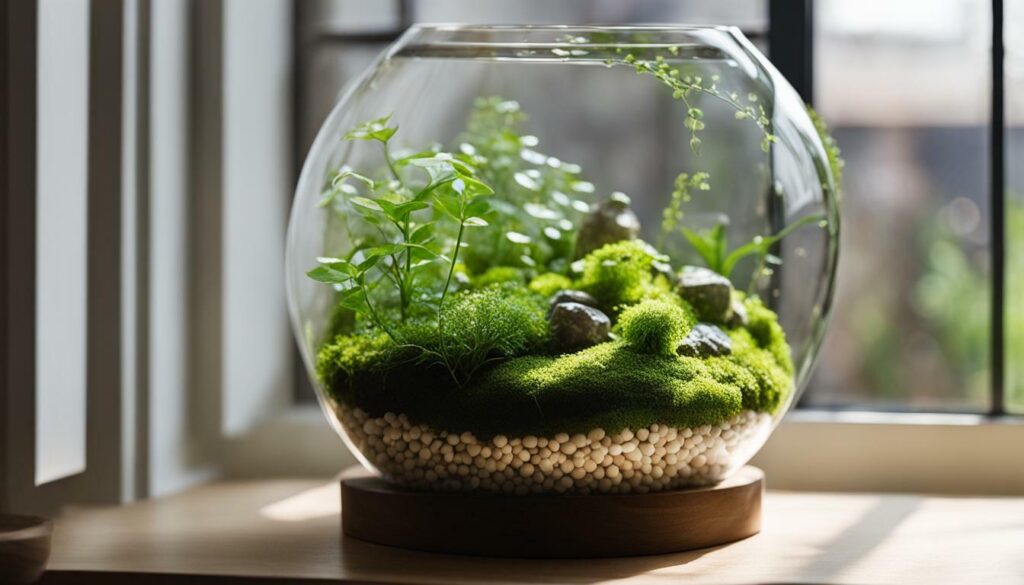
Aside from String of Pearls, a variety of other plants can also thrive in terrariums. Air plants, haworthia, jade plants, button ferns, Mexican snowball, and stonecrop are excellent choices for open terrariums, while artillery ferns and prayer plants are better suited for closed terrariums due to their humidity requirements.
By carefully selecting and arranging trailing succulents and cascading plants with long stems, you can create a captivating terrarium that brings nature’s beauty into your living space. Let your creativity flourish as you design your miniature garden and enjoy the endless possibilities of these stunning terrarium plants.
Essential Care Tips for Terrarium Plants
Terrarium plants, including String of Pearls, are generally easy to care for, making them perfect for those seeking low-maintenance greenery indoors. With the right conditions and a few simple guidelines, your terrarium plants will thrive and add a touch of natural beauty to your home or office.
Here are some essential care tips to keep in mind:
- Lighting: Most terrarium plants, including String of Pearls, prefer bright, indirect light. Place your terrarium near a window where it can receive bright, filtered light for at least a few hours each day.
- Ventilation: Good airflow is crucial for terrarium plants. Make sure your terrarium has proper ventilation to prevent excessive moisture and the growth of mold or fungus.
- Watering: Terrarium plants have different watering needs. For String of Pearls, it’s important to water lightly and allow the soil to dry out slightly between waterings. Overwatering can lead to root rot, so it’s better to underwater than overwater.
- Pruning and Cleaning: Regular pruning helps maintain the shape and health of your terrarium plants. Remove any dead or yellowing leaves and trim back any overgrown stems. Additionally, keeping the terrarium clean from dust and debris will ensure better air circulation and prevent pests.
Remember, each terrarium plant is unique, and it’s important to research specific care requirements for the plants you choose. By providing the right conditions and following these care tips, your terrarium plants will flourish and bring a touch of nature indoors.
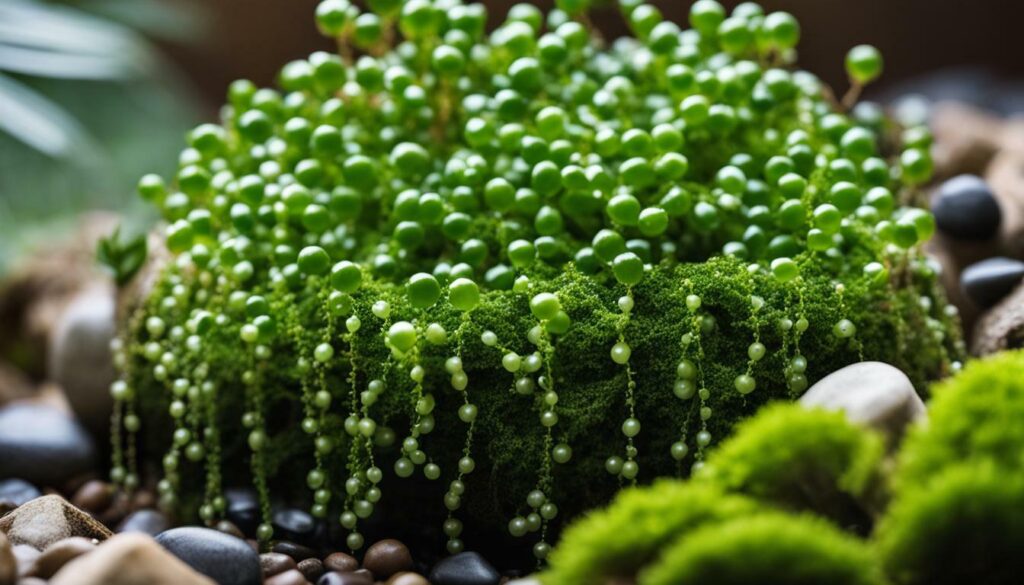
| Plant Name | Lighting | Watering | Pruning |
|---|---|---|---|
| String of Pearls | Bright, indirect light | Light watering, allow soil to dry out slightly | Regular pruning to maintain shape and remove dead leaves |
| Air Plants | Bright, indirect light | Soak in water for 20-30 minutes every week | Remove dead leaves and flowers |
| Jade Plants | Bright light, some direct sunlight | Allow soil to dry out between waterings | Prune to maintain shape and remove dead leaves |
“Terrarium plants add a touch of natural beauty that brings life and tranquility to any indoor space.” – Terrarium Enthusiast
String of Pearls: Care and Aesthetics
String of Pearls is a unique succulent that thrives in terrariums, with its distinctive round, pea-like leaves adding a whimsical touch to any enclosed green space. Its cascading vines create a mesmerizing effect, making it a popular choice for terrarium enthusiasts looking to create a visually appealing display. With its low-maintenance nature and striking aesthetics, String of Pearls is a must-have plant for indoor terrariums.
When it comes to caring for String of Pearls in a terrarium, lighting is essential. This succulent thrives in bright, indirect light, so placing it near a window or providing artificial grow lights can help it thrive. However, be cautious of intense direct sunlight, as it can scorch the delicate foliage.
Another crucial aspect of caring for String of Pearls is proper watering. As a succulent, it is highly adaptable to dry conditions and requires minimal watering. Overwatering can lead to root rot and cause the plant to deteriorate. Water the plant sparingly, allowing the soil to dry out slightly between waterings. It is always better to underwater than to overwater this plant.
In terms of soil requirements, String of Pearls prefers a well-draining mix. A combination of cactus potting mix and perlite provides the ideal conditions for this succulent. Ensure that the terrarium has good drainage to prevent waterlogging that can lead to root rot.
String of Pearls is a unique and stunning addition to any terrarium. Its distinctive appearance and low-maintenance nature make it an ideal choice for both beginners and experienced terrarium enthusiasts. With proper care and attention to lighting, watering, and soil, you can enjoy the beauty of this succulent cascading through your miniature green oasis.
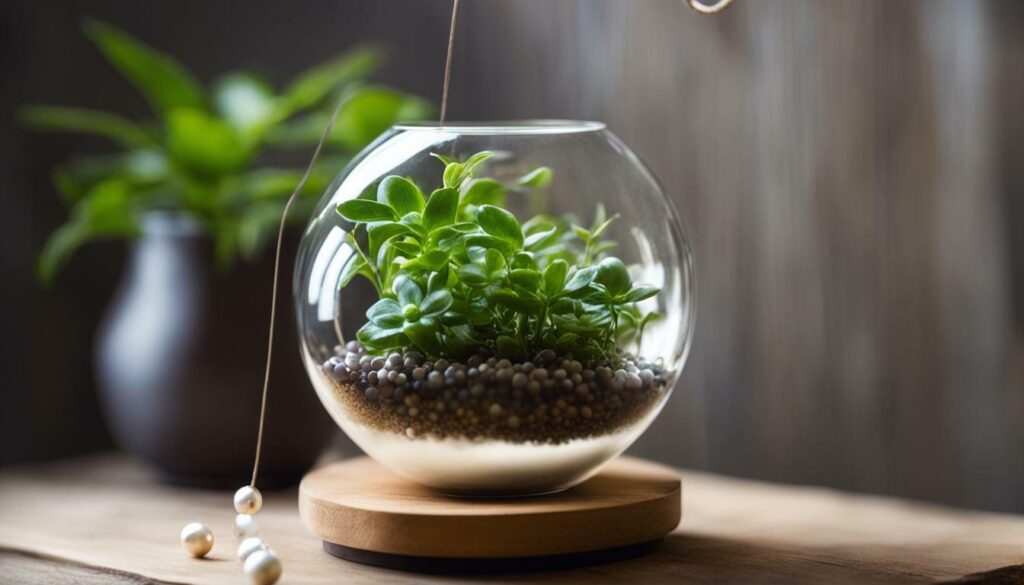
Apart from String of Pearls, there are several other plant options that flourish in open terrariums, such as air plants, jade plants, and Chinese money plants. These plants not only enhance the visual appeal but also thrive in the lower humidity and fresh air environment of open terrariums.
Air plants, also known as Tillandsias, are unique and fascinating plants that don’t require soil to grow. They absorb nutrients and moisture from the air, making them ideal for open terrariums. You can attach them to driftwood or other decorative elements within the terrarium, creating an ethereal and natural look.
Jade plants, with their thick, succulent leaves and tree-like appearance, are another excellent choice for open terrariums. They are known for their resilience and ability to thrive in different environments. Their vibrant green leaves provide a striking contrast to the pebbles or moss in the terrarium, adding a touch of elegance.
Chinese money plants, also known as Pilea peperomioides, are highly sought after for their round, coin-shaped leaves. They are easy to care for and can add a unique and eye-catching element to any open terrarium. The deep green foliage and compact growth habit make them a perfect choice for smaller terrariums.
Recommended Plant Options for Open Terrariums
| Plant | Characteristics |
|---|---|
| Air plants | Require no soil, absorb nutrients from the air |
| Jade plants | Thick, succulent leaves; tree-like appearance |
| Chinese money plants | Round, coin-shaped leaves; compact growth habit |
These plants, combined with String of Pearls, can create a diverse and visually captivating open terrarium. Experimenting with different plant combinations and arrangements will allow you to showcase your creativity and design a terrarium that reflects your unique style.
“Open terrariums offer the perfect opportunity to showcase a variety of plant species and create a miniature garden within a glass container.” – Terrarium Enthusiast
Remember to provide proper care and maintenance for your open terrarium, including regular watering, occasional fertilization, and monitoring the humidity levels. Keep in mind the specific needs of each plant species to ensure their well-being and longevity in the terrarium environment.
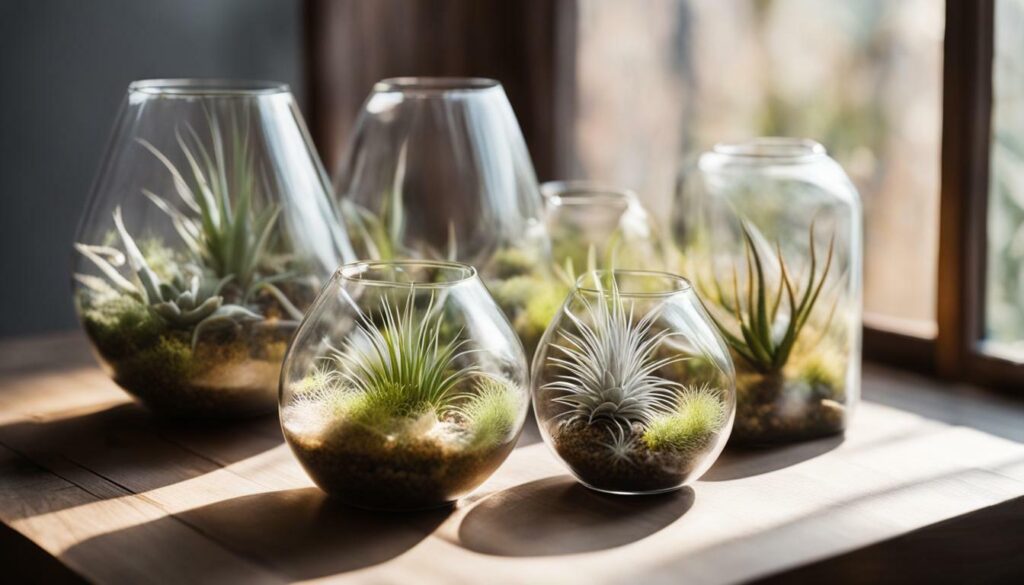 Vines play a unique role in terrariums, offering trailing and ground cover options to enhance the overall aesthetic of your enclosed garden. These versatile plants can add a touch of whimsy and create a lush, jungle-like atmosphere within your terrarium. Let’s explore some popular vine options that are perfect for adding depth and dimension to your terrarium.
Vines play a unique role in terrariums, offering trailing and ground cover options to enhance the overall aesthetic of your enclosed garden. These versatile plants can add a touch of whimsy and create a lush, jungle-like atmosphere within your terrarium. Let’s explore some popular vine options that are perfect for adding depth and dimension to your terrarium.Creeping Figs (Ficus pumila)
One popular choice for ground cover in terrariums is the creeping fig (Ficus pumila). Its small, heart-shaped leaves and fast-growing nature make it an excellent option for creating a dense carpet of greenery. Creeping figs thrive in high humidity environments and can be trained to climb walls or cascade down from hanging baskets.Dischidia nummularia
Another trailing vine that works beautifully in terrariums is Dischidia nummularia, also known as String of Nickels. Its round, succulent-like leaves resemble little coins and create a captivating cascading effect. This vine is perfect for hanging terrariums or as a focal point in a tabletop display.To help you visualize the beauty of these vine options, here is a table summarizing their key characteristics:| Vine Options | Key Characteristics |
|---|---|
| Ficus pumila | Small, heart-shaped leaves; fast-growing; dense ground cover |
| Dischidia nummularia | Round, succulent-like leaves; cascading effect; ideal for hanging terrariums |
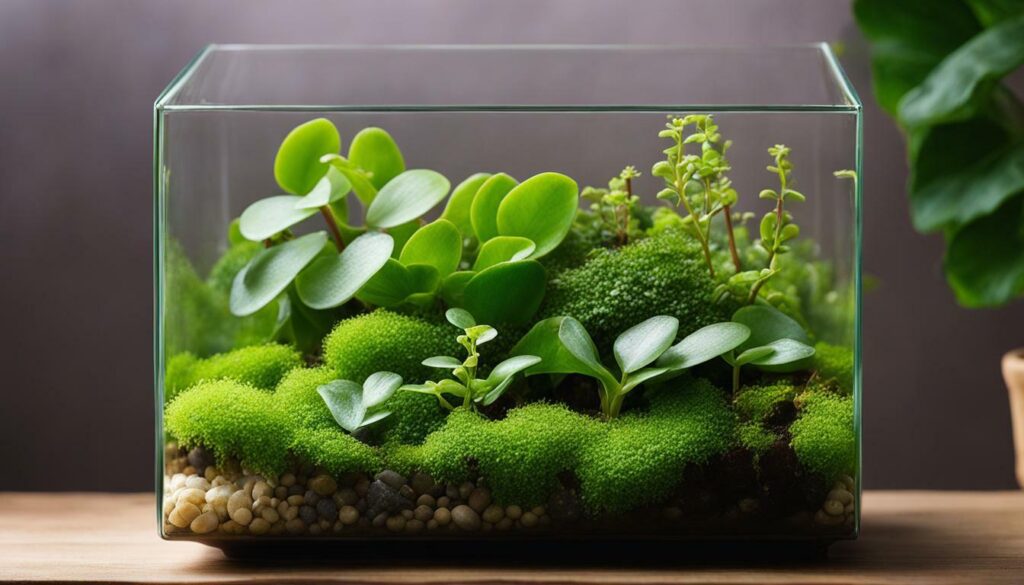 Now that you have a better understanding of the trailing and ground cover vine options for terrariums, let your creativity run wild and experiment with different combinations. Your terrarium will become a captivating centerpiece in your home, bringing a touch of nature and tranquility to your living space.
Now that you have a better understanding of the trailing and ground cover vine options for terrariums, let your creativity run wild and experiment with different combinations. Your terrarium will become a captivating centerpiece in your home, bringing a touch of nature and tranquility to your living space.Vines like Syngonium, Philodendron micans, and Epipremnum aureum can serve as striking feature plants, adding a touch of elegance to your terrarium. These beautiful vines not only enhance the aesthetic appeal of your terrarium but also provide a unique and dynamic element to the overall composition. Their trailing nature and intricate foliage create a visually captivating display that will surely impress.
Syngonium is a popular choice for terrariums due to its heart-shaped leaves and vibrant colors. Its compact growth habit makes it an ideal vine for smaller terrariums. The variety of foliage patterns, ranging from solid green to variegated shades of pink and white, adds a dramatic and eye-catching element to any terrarium. Pair it with other terrarium plants for a visually stunning arrangement.
Philodendron micans, also known as the Velvet Leaf Philodendron, is another excellent option for creating a beautiful terrarium. This vine features velvety, heart-shaped leaves with a rich, deep green color. Its cascading growth habit adds a sense of movement and lushness to your terrarium. Philodendron micans is a low-maintenance plant that thrives in humid environments, making it an ideal choice for closed terrariums.
If you’re looking to add a touch of exotic flair to your terrarium, consider Epipremnum aureum. Also known as Devil’s Ivy or Pothos, this vine features heart-shaped leaves in shades of green and yellow. Its versatility allows it to thrive in both open and closed terrariums. Epipremnum aureum is known for its vigorous growth and ability to trail or climb, making it perfect for creating a lush and verdant terrarium.
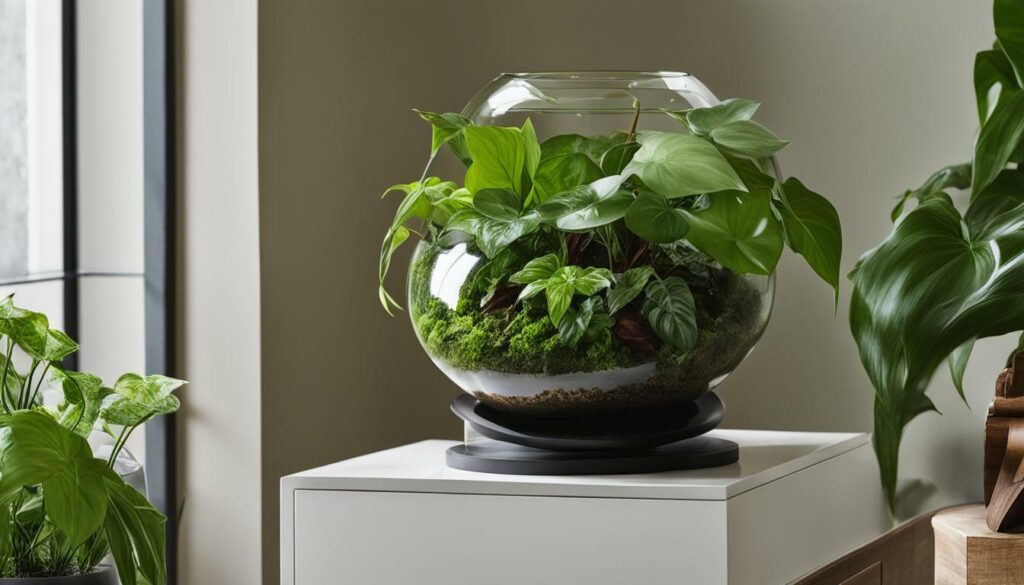
Terrarium Care Tips: Proper Ventilation and Maintenance
Taking proper care of your terrarium involves maintaining proper ventilation, regular pruning and cleaning, and ensuring the right temperature and humidity levels for your plants. Adequate ventilation is essential to prevent moisture buildup and mold growth inside the terrarium. It is recommended to remove the lid for a few hours each day or place the terrarium in a well-ventilated area. This allows fresh air to circulate, preventing stagnant air and promoting plant health.
Regular pruning and cleaning are important to keep your terrarium looking its best. Trim any dead or damaged leaves and remove any fallen debris to maintain a clean and tidy appearance. Pruning also helps control the growth of your plants and prevents overcrowding. Use clean, sharp tools to avoid introducing any pathogens into the terrarium.
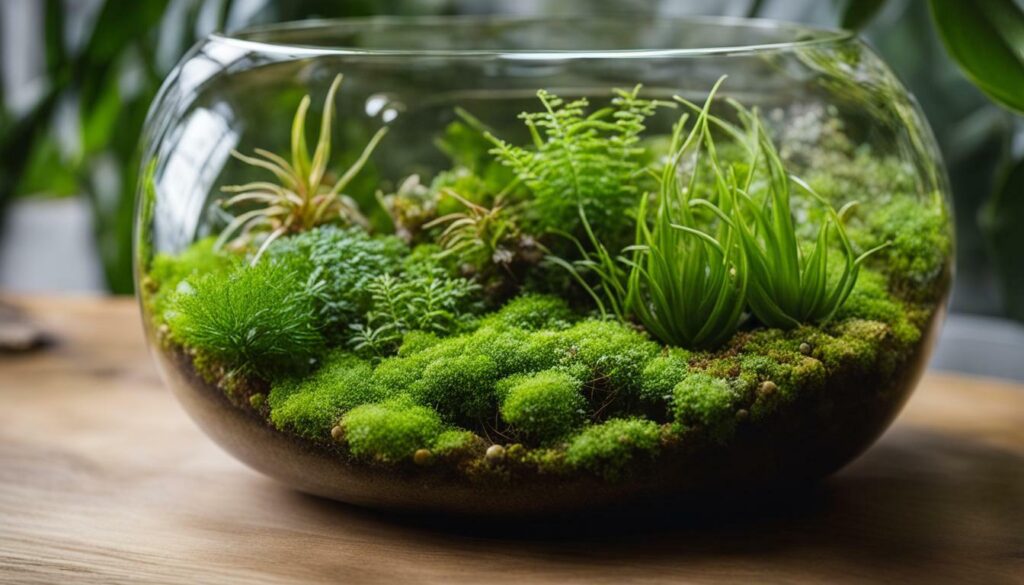
Temperature and humidity are crucial factors to consider when caring for your terrarium plants. Most terrarium plants thrive in temperatures between 70-80°F (21-27°C). Avoid placing the terrarium near drafts or direct heat sources, as sudden temperature fluctuations can stress the plants.
Humidity levels differ between open and closed terrariums. Open terrariums typically have lower humidity levels, while closed terrariums create a more humid environment. It’s important to choose plants that are adapted to the specific humidity requirements of your terrarium. You can monitor the humidity levels with a hygrometer and adjust them accordingly by adjusting the watering frequency or misting the plants.
By following these terrarium care tips, you can ensure the health and longevity of your terrarium plants. With proper ventilation, regular pruning and cleaning, and attention to temperature and humidity, your terrarium will thrive and bring beauty to your indoor space.
Conclusion
Terrarium plants, especially those with long stems, offer endless possibilities for creating stunning and unique enclosed gardens that can transform any indoor space. These captivating worlds encapsulated within glass jars bring a touch of nature and artistry to your living space.
One popular terrarium plant, the String of Pearls, adds a whimsical and beautiful touch to any terrarium. With its round, pea-like leaves, this succulent thrives in terrariums and adds a touch of elegance to the overall aesthetic.
When it comes to terrarium types, open and closed terrariums offer different environments for various plants. Open terrariums provide lower humidity and fresh air, making them perfect for plants like cacti, succulents, and jade plants. On the other hand, closed terrariums create a mini ecosystem with higher humidity, ideal for humidity-loving plants such as artillery ferns and prayer plants.
Caring for terrarium plants involves meeting their light requirements, ensuring proper ventilation, adhering to watering guidelines, and regular pruning and cleaning. For example, String of Pearls prefers bright, indirect light and requires light watering, allowing the soil to dry out slightly between waterings.
Alongside String of Pearls, other plants that thrive in open terrariums include air plants, haworthia, jade plants, button ferns, Chinese money plants, creeping figs, Mexican snowball, and stonecrop. These plants add variety and visual interest to your terrarium.
In addition to plants, vines can also be used to create a wild and natural look in a terrarium. Creeping vines like Ficus pumila and Pilea glauca are perfect for ground cover, while hanging vines like Dischidia nummularia and Epipremnum aureum create a cascading effect. Vines like Syngonium and Philodendron micans can be showcased as feature plants.
Proper care for String of Pearls includes using well-draining soil and providing good drainage for the pot. This plant prefers warm and dry conditions with low humidity, making it important to ensure proper ventilation. It requires at least four hours of direct sunlight daily to prevent balding at the base and should be watered lightly, allowing the soil to slightly dry out between waterings.
Other tips for terrarium care include regular pruning and cleaning, as well as meeting the temperature and humidity needs of the plants. By following these guidelines, you can maintain a healthy and vibrant terrarium garden.
With a wide variety of plants to choose from, including String of Pearls and other vines like Ficus pumila, Dischidia nummularia, Syngonium podophyllum Neon Robusta, Philodendron micans, and many more, you can unleash your creativity and create a unique and stunning terrarium that will be the focal point of any indoor space.
Can String of Pearls and Snake Plants Thrive Together in the Same Terrarium?
Yes, thriving snake plants for terrariums can coexist with string of pearls plants. Both plants have similar light and water requirements, making them ideal terrarium companions. Snake plants are known for their air-purifying qualities, while string of pearls add a graceful cascading feature. Together, they create a beautiful and harmonious terrarium display.
FAQ
What are terrariums?
Terrariums are like captivating worlds encapsulated within glass jars that offer a unique opportunity to enhance your indoor garden and inject an artistic dimension into your living space.
What is String of Pearls?
String of Pearls is a popular plant that thrives in terrariums. It is a succulent with round, pea-like leaves that add a beautiful and whimsical touch to any terrarium.
What are the different types of terrariums?
There are open and closed types of terrariums. Open terrariums are ideal for plants that like lower humidity and fresh air, such as cacti, succulents, and jade plants. Closed terrariums create a miniature ecosystem with higher humidity, making them suitable for humidity-loving plants like artillery ferns and prayer plants.
How do I care for a terrarium?
Terrarium care involves meeting the light requirements of the plants, ensuring proper ventilation, adhering to watering guidelines, and regular pruning and cleaning.
What light does String of Pearls prefer?
String of Pearls prefers bright, indirect light.
Which plants thrive in open terrariums?
Other plants that thrive in open terrariums include air plants, haworthia, jade plants, button ferns, Chinese money plants, creeping figs, Mexican snowball, and stonecrop.
Can I use vines in my terrarium?
Yes, vines can be used in terrariums to create a wild look. Creeping vines like Ficus pumila and Pilea glauca are ideal for ground cover, while hanging vines like Dischidia nummularia and Epipremnum aureum can be mounted on vivarium backgrounds or allowed to trail down. Vines like Syngonium and Philodendron micans can be used as feature plants.
How should I pot String of Pearls in my terrarium?
The soil for String of Pearls should be light and well-draining, and the pot should have good drainage holes. It is important to pot the plant high enough so that the crown is level with the pot edge to avoid rotting at the soil level.
What are the care requirements for String of Pearls?
String of Pearls prefers warm and dry conditions with low humidity. It needs direct sunlight for at least 4 hours daily to avoid balding at the base. Overwatering should be avoided, and it is recommended to water lightly and let the soil dry out slightly between waterings.
What other vines can I use in a terrarium?
Other vines that can be used in a terrarium include Ficus pumila, Dischidia nummularia, Syngonium podophyllum Neon Robusta, Philodendron micans, Peperomia, Procris repens, Epipremnum aureum ‘Manjula’, Tradescantia Zebrina, Pilea, Monstera siltepecana, and Marcgravia.
What are some general terrarium care tips?
General terrarium care tips include providing proper ventilation, regular pruning and cleaning, and meeting the temperature and humidity needs of the plants.

